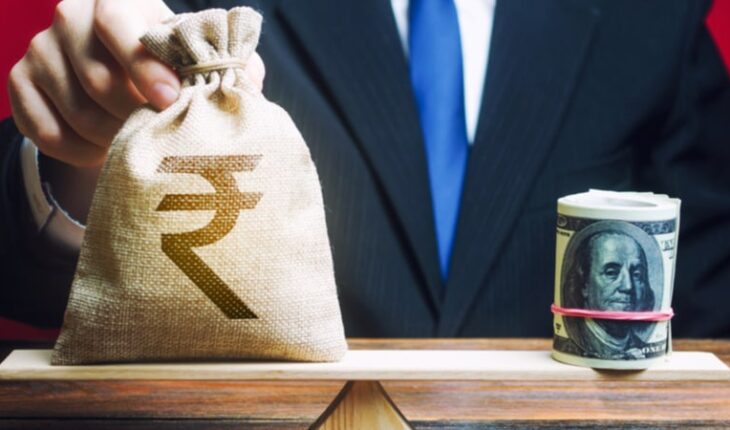
Talking about India is facing most of its economic odds in the form of, unemployment, depreciation, CAD, etc. India is witnessing a continuous depreciation in its currency with a more than 9% depreciation in 2022. There is a difference between depreciation and devaluation as the second is done to make our exports cheaper to increase demand for domestic exports in the international market.
The currency exchange rate is slated to hit the low point of 83.2 per dollar and according to the projections of the International Monetary Fund, it is going to depreciate further to `94 per dollar. Although the rupee has been continuously depreciating throughout the period since the adoption of a flexible exchange rate system, the intensity of depreciation in the current times is high compared to what it used to be in the past. Many experts, however, believe that the Indian rupee has not performed that badly in comparison to other currencies. While the rupee has lost 9.8 per cent in the calendar year 2022, it has remained much more stable compared to the Japanese Yen, which is down 22.6% against the USD year to date. Others like the South Korean Won are down 17.1%, while the pound sterling is down 16.6%. The Euro is down 14.2%, the Philippines peso is down 13.6%, Taiwan dollar is down 13.5%. The currencies that are more stable than the INR include Indonesian Rupiah ( down 8%), Singapore’s dollar 5.4%), and the Hong Kong Dollar ( down 0.7%, which showed data analysed by Kotak Institutional Securities.
Although there are many reasons for the depreciation of the rupee, some of the major causes can be discussed here. First is the Russia–Ukraine war leading to a rise in oil prices. India is one of the largest importers of crude oil, importing about 80% of its oil from outside. Hence, it needs to pay more in import expenditures, which ultimately leads to an increase in the supply of the rupee in the market and results in its depreciation. Second is the uncertainty created by factors like the US economic slowdown, which enforces investors to park their assets in safe havens. Adding to that, the US Federal Reserve’s tapering is attracting investors to move their assets out from low-yielding nations back to the US. All this resulted in the outflow of portfolio investments from India.
Post-COVID-19, foreign direct investment (FDI) and foreign institutional investors (FII) favoured developed countries the most with an increase of 114% in the US, which is the largest host economy. Similarly, the FDI in China saw a 20% increase in 2021, while FDI inflows to India in 2021 were 26% lower, mainly because large merger and acquisition deals recorded in 2020 were not repeated. FIIs have also been on a selling spree across most emerging markets, including India where they have sold over $7 billion worth of equities thus far in 2022 and over $11 billion since October 2021 when they started to unwind positions in India. Analysts say FIIs may choose to remain on the sidelines for now and come back strongly in the latter half of 2022 when the markets face relatively less uncertainty.
Depreciation of the currency is not always bad; sometimes countries need their currency to devaluate to curb the balance of payments disequilibrium. A depreciated rupee can benefit the Indian economy by boosting exports, which account for 18.7% of India’s GDP. But in the current scenario of low global demand, it is not going to benefit the country. Besides, the benefits, if acquired via exports, will be much lower than the losses, which India will have to face in the form of higher import prices. Due to depreciation, India’s trade deficit is rising tremendously to a record high of $26.1 billion and is expected to be $105 billion by the end of this fiscal year, which equals 3% of its GDP. Efforts in the form of a tight monetary policy, rise in interest rates, and use of forex reserves are being made by the Reserve Bank of India (RBI) to pull the Indian economy out of this situation. In this process, India’s forex reserves fell by $7.5 billion to their lowest in over 20 months as the RBI stepped up its intervention to protect the rupee from tumbling past `85 per dollar.
This is a double curse for the common man with the country going under high inflation and the prices of everyday items drastically going up.
Union Finance Minister Nirmala Sitharaman, however, recently said that the Indian currency is relatively better placed than other global currencies against the greenback.
In the meantime, as the currency volatility continues, let’s decode what this means for us.
How does a weak rupee impact you and the economy?
Since India mostly depends on imports, including crude oil, metals, electronics, etc. the country makes payments in US dollars. Now if the rupee is weak, it has to pay more for the same quantity of items. In such cases, the cost of raw materials and production goes up which gets passed on to the consumers.
On the other hand, a weakening domestic currency boosts exports as shipments get more competitive and foreign buyers gain more purchasing power. However, in the current scenario of weak global demand and persistent volatility, exporters are not supportive of the currency fall.
The falling rupee’s biggest impact is on inflation, given India imports over 80 per cent of its crude oil, which is the country’s biggest import. The global crude prices have sustained at over $100 a barrel since Russia invaded Ukraine in February this year. High oil prices and a weaker rupee will only add to inflationary pressures in the economy.
Dr.Harvinder Kaur, Associate Professor in Economics, Ambala, views are personal.





